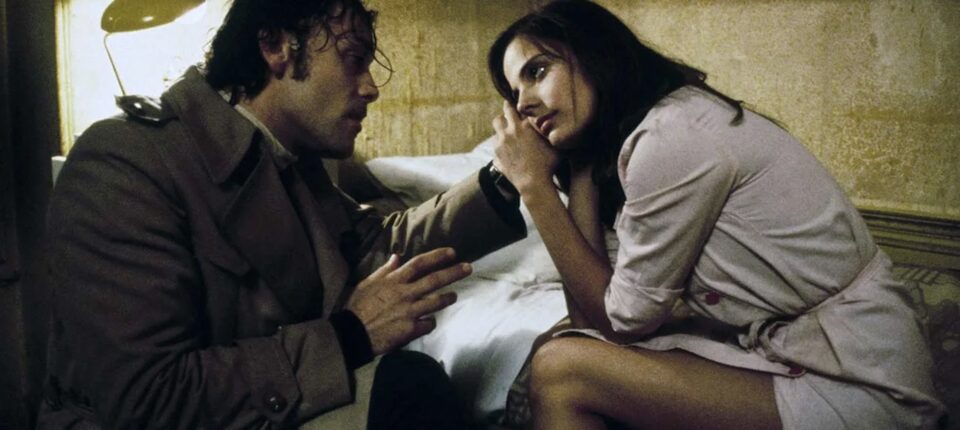Alain Corneaus’s 1979 film Série Noire, which adapts Jim Thompson’s 1954 novel A Hell of a Woman, is set in the dilapidated suburbs of Paris. Its daydreaming, neurotic protagonist longs to escape his physical surroundings and their associated monotony. When he attempts to rid society of the corruption he observes, though, he ends up breaking down before breaking free—tearing his life apart before tearing from it. Perhaps the film argues that freedom from mediocre life within the tedium of society can only be achieved by rejecting the emphasis society places on structure, traditions, and a fetishization of a certain kind of proper life. This might not sound like the plot of a traditional neo-noir, and that’s because Série Noire is not a traditional neo-noir. It is a kind of fairy tale—an upside down, crumbling, psychopathic perversion of a fairy tale, that slowly grows in its sense of noir as it gets further and further from its “happily ever after.”
Corneau, and the screenwriter screenwriter Georges Perec, underscore Thompson’s characteristic bleakness, representing Paris as devoid of the romantic imagination to which it normally belongs (at least on film), as full of corruption and disrepair. The mise-en-scene is a palette of grays, browns, and faded pastels. It’s always raining in these monochromatic, low-rent suburbs. The battered city and its shabby environs become a visual metaphor for the enduring dreariness embodied by the main character, Franck Poupart (Patrick Dewaere)—a maladjusted door-to-door salesman married to a woman he hates (Myriam Boyer). Franck wants something more; he begins the film by looking for a delinquent customer and stumbles on something far more sinister.
Franck fantasizes about a more noble or dramatic life,a life he believes he has finally found when he encounters a young damsel, Mona (Marie Trintignant, just sixteen years old). She is trapped and exploited by her witch-like, elderly aunt, who forces Monda to perform sexual favors on men to whom she owes money, in lieu of payment. Franck, appalled, uses the notion that he must save her and rid her from the corrupt beings who abuse her as a means to escape the stagnant misery of his own life—and his desperation to do so results in his violent explosions that only contribute to the crumbling of Paris and society in general.
Franck imagines that he is Mona’s Prince Charming. Clad in a gray trench coat for the whole film, looks like something of a PI. But he is neither… he’s a homicidal madman, spending the rest of the film attempting to “clean up” the streets (that is… killing undesirables in Mona’s proximity), so he can release her from the prison of her aunt’s home and give her the life, and the pristine surroundings, he feels she deserves.
He thinks all this murder and destruction is beneficial to him, them—his last lines in the film, uttered in the street at night, shortly after he murders his wife (who had discovered the murders he had committed in order to initially free Mona and now risks his easy), are repetitions of the cry “We have nothing to be afraid of anymore!” He celebrates his newfound freedom by twirling Mona in the street, not by pulling her away; he now believes that he has cured his surroundings of their negative qualities, and the notion of “escaping” is not necessarily relevant anymore.
However, the peripheral-Paris surroundings are just as gloomy as they had been during his misery, and they foreshadow that his celebration will not last—as does Corneau’s artistic decision that the camera capture the continued movement of Franck’s ecstatic twirling of Mona. Franck stands still while he twirls her—even though he is free enough to move wildly, he still is fixed in the same place; this cyclical, spinning gesture and his lack of displacement is a reminder that nothing about his situation will ultimately change; it just has the illusion of movement, the illusion of transformation.
Ominously, the beginning strikes a similar note—opening on an establishing shot with a deserted lot in the foreground, positioned in front of an unfamiliar sect of the Paris skyline—filled with construction equipment and Brutalist buildings. The city, looks unfriendly, unfamiliar, and forgotten. The camera cuts immediately to a long shot of the main character, Franck, who has just stepped out of his car. Standing just underneath these symbolic structures, Franck engages in elaborate pantomime that mimics everything from secret agent missions to romantic dancing. Through this subtle visual juxtaposition of the world in disrepair and then a figure who demonstrates such earnest delusions and therefore is clearly unhinged, the film communicates instantly that Franck, who longs to be fanciful and chivalric, is nothing more than a mirror of his location—a lonely, dismal, and neglected force who is unsuccessfully attempting to construct a façade of grandeur.
Although the public spaces visible in these unchanging suburbs of Paris mirror the dysfunction of the people who inhabit it, namely the neurotic and daydreaming Franck, all of the violence occurs within private spaces—apartments and houses. Therefore, the film reinforces, the dereliction of these suburbs is in fact, the real façade—an ugly mask covering an even more unpleasant underbelly.
Série Noire uses the noir genre’s preoccupation with solitary location to illuminate the pessimistic themes of the fruitlessness of mobility to better states, and the destruction caused by those who dare to challenge the order of life. Corneau focuses on the goings-on within a degraded sliver of Parisian life to effectively capture, in microcosm, the deep darknesses of the human heart.

















